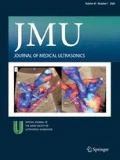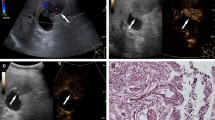Abstract
The major role of conventional ultrasonography (US) can be divided into three processes: cancer screening, differential diagnosis, and assessment of the depth of tumor invasion. As US is a simple and minimally invasive modality, it is widely used for cancer screening and health checkups. Both gallbladder (GB) polyps and thickened wall of the GB are common US findings. On the contrary, US is prone to interference from gas echoes, and its diagnostic accuracy depends on both the US technology and the ability of sonographers. It is also important to be well acquainted with characteristic artifacts and how to manage their influence. Furthermore, magnified images acquired using high-resolution US (HRUS) are strongly helpful to pick up small lesions. As for differential diagnosis, classification of GB polypoid lesions (GPLs) into pedunculated or sessile (broad-based) types is very important. Cholesterol polyps in pedunculated lesions and localized adenomyomatosis (ADM) in sessile lesions are the most important targets to be differentiated. Furthermore, significant findings including number, size, growth rate, shape, internal echo, surface contour, and internal structure should be evaluated and judged as a whole. Usually, US delineates the GB wall as a two- or three-layer structure. However, as the inner hypoechoic layer includes not only the mucosa and muscularis propria but also the fibrous layer of subserosa, the differentiation between T1 (confined to the mucosa or muscularis propria) and T2 (invading the subserosa) based on the layer structure is difficult. Shape, size, and internal echo structure may be helpful for further assessment.
Similar content being viewed by others
Abbreviations
- US:
-
Ultrasonography
- GB:
-
Gallbladder
- GPL:
-
Gallbladder polypoid lesion
- GBC:
-
Gallbladder carcinoma
- HRUS:
-
High-resolution ultrasonography
- ADM:
-
Adenomyomatosis
- RAS:
-
Rokitansky–Aschoff sinuses
- EUS:
-
Endoscopic ultrasound
References
Jørgensen T, Jensen KH. Polyps in the gallbladder. A prevalence study. Scand J Gastroenterol. 1990;25:281–6.
Segawa K, Arisawa T, Niwa Y, et al. Prevalence of gallbladder polyps among apparently healthy Japanese: ultrasonographic study. Am J Gastroenterol. 1992;87:630–3.
Chen CY, Lu CL, Chang FY, Lee SD. Risk factors for gallbladder polyps in the Chinese population. Am J Gastroenterol. 1997;92:2066–8.
Mihara S, Yoshioka R, Tamada M, et al. Update of ultrasonographic screening for gallbladder cancer in mass survey (in Japanese). Tan Sui. 2005;26:801–4.
Okaniwa S, Iwashita K. How should we evaluate the pancreatobiliary system? Pitfalls and practical solutions (in Japanese with English abstract). Jpn J Med Ultrason. 2018;45:471–80.
Kim JH, Lee JY, Baek JH, et al. High-resolution sonography for distinguishing neoplastic gallbladder polyps and staging gallbladder cancer. AJR Am J Roentgenol. 2015;204:W150–9. https://doi.org/10.2214/AJR.13.11992.
Lee JS, Kim JH, Kim YJ, et al. Diagnostic accuracy of transabdominal high-resolution US for staging gallbladder cancer and differential diagnosis of neoplastic polyps compared with EUS. Eur Radiol. 2017;27:3097–103.
Jang JY, Kim SW, Lee SE, et al. Differential diagnostic and staging accuracies of high-resolution ultrasonography, endoscopic ultrasonography, and multidetector computed tomography for gallbladder polypoid lesions and gallbladder cancer. Ann Surg. 2009;250:943–9.
Chantarojanasiri T, Hirooka Y, Kawashima H, Ohno E, Kongkam P, Goto H. The role of endoscopic ultrasound in the diagnosis of gallbladder diseases. J Med Ultrason. 2017;44:63–70.
Kubota K, Bandai Y, Noie T, et al. How should polypoid lesions of the gallbladder be treated in the era of laparoscopic cholecystectomy? Surgery. 1995;117:481.
Shinkai H, Kimura W, Muto T. Surgical indications for small polypoid lesions of the gallbladder. Am J Surg. 1998;175:114–7.
Sun XJ, Shi JS, Han Y, Wang JS, Ren H. Diagnosis and treatment of polypoid lesions of the gallbladder: report of 194 cases. Hepatobiliary Pancreat Dis Int. 2004;3:591–4.
Kozuka S, Tsubone N, Yasui A, et al. Relation of adenoma to carcinoma in the gallbladder. Cancer. 1982;50:2226–34.
Tsuchiya Y, Uchimura M. Collective review of 503 cases of small polypoid lesions (less than 20 mm in maximum diameter) of the gallbladder: size distribution in various diseases and that of the depth of carcinomatous invasion (in Japanese). Jpn J Gastroenterol. 1986;83:2086–7.
Wiles R, Thoeni RF, Barbu ST, et al. Management and follow-up of gallbladder polyps Joint guidelines between the European Society of Gastrointestinal and Abdominal Radiology (ESGAR), European Association for Endoscopic Surgery and other Interventional Techniques (EAES), International Society of Digestive Surgery—European Federation (EFISDS) and European Society of Gastrointestinal Endoscopy (ESGE). Eur Radiol. 2017;27:3856–66.
Wiles R, Varadpande M, Muly S, Webb J. Growth rate and malignant potential of small gallbladder polyps—systematic review of evidence. Surgeon. 2014;12:221–6.
Park JY, Hong SP, Kim YJ, Kim HJ, Kim HM, Cho JH, et al. Long-term follow-up of gallbladder polyps. J Gastroenterol Hepatol. 2009;24:219–22.
Zielinsky MD, Atwell TD, Davis PW, Kendrick ML, Que FG. Comparison of surgical resected polypoid lesions of the gallbladder to their pre-operative ultrasound characteristics. J Gatrointest Surg. 2009;13:19–25.
Park HY, Oh SH, Lee KH, Lee JK, Lee KT. Is cholecystectomy a reasonable treatment option for simple gallbladder polyps larger than 10 mm? World J Gastroenterol. 2015;21:4248–54.
Ishida K, Fujita N, Noda Y, et al. A case of early gallbladder cancer resected after follow up for 8 years (in Japanese). Jpn J Gastroenterol. 1995;92:804–8.
Okaniwa S, Fujita N, Noda Y, et al. The growth process of nodular-invasive gallbladder cancer observed by ultrasonography: a case report (in Japanese). Jpn J Gastroenterol. 1996;93:287–92.
Kimura K, Fujita N, Noda Y, et al. A case of pedunculated polypoid cancer associated with flat-type cancer of the gallbladder. Dig Endosc. 2005;17:93–6.
Shin SR, Lee JK, Lee KH, et al. Can the growth rate of a gallbladder polyp predicts a neoplastic polyp? J Clin Gastroenterol. 2009;43:865–8.
Ukai K, Akita Y, Mizuno S, et al. Cholesterol polyp of the gallbladder showing rapid growth and atypical changes—a case report-. Hepatogastroenterology. 1992;39:371–3.
Jang YS, Lee JH, Kim JY, et al. Surgical outcomes and risk factors for gallbladder carcinoma of polypoid lesions of gallbladder. Korean J Hepatobiliary Pancreat Surg. 2005;9:164–70.
Bhatt NR, Gillis A, Smoothey CO, Awan FN, Ridgway PF. Evidence based management of polyps of the gall bladder: a systematic review of the risk factors of malignancy. Surgeon. 2016;14:278–86.
Park JK, Yoon YB, Kim Y-T, Ryu JK, Yoon WJ, Lee SH, et al. Management strategies for gallbladder polyps: is it possible to predict malignant gallbladder polyps? Gut Liver. 2005;2:88–94.
Albores-Saavedra J, Vardaman CJ, Vuitch F. Non-neoplastic polypoid lesions and adenomas of the gallbladder. Pathol Annu. 1993;28:145–77.
Fei X, Lu WP, Luo YK, et al. Contrast-enhanced ultrasound may distinguish gallbladder adenoma from cholesterol polyps: a prospective case–control study. Abdom Imaging. 2015;40:2355–63.
Sugiyama M, Atomi Y, Kuroda A, Muto T, Wada N. Large cholesterol polyps of the gallbladder: diagnosis by means of US and endoscopic US. Radiology. 1995;196(2):493–7.
Akatsu T, Aioura K, Shimadsu M, et al. Can endoscopic ultrasonography differentiate nonneoplastic from neoplastic gallbladder polyps? Dig Dis Sci. 2006;51:416–21.
Choi WB, Lee SK, Kim MH, et al. A new strategy to predict the neoplastic polyps of the gallbladder based on a scoring system using EUS. Gastrointest Endosc. 2000;52:372–9.
Sadamoto Y, Oda S, Tanaka M, et al. A useful approach to the differential diagnosis of small polypoid lesions of the gallbladder, utilizing an endoscopic ultrasound scoring system. Endoscopy. 2002;34:959–65.
Kimura K. Diagnosis for pedunculated polypoid lesions of the gallbladder by endoscopic ultrasonography (in Japanese with English abstract). Jpn J Gastroenterol. 1997;94:249–60.
Sugiyama M, Xie XY, Atomi Y, et al. Differential diagnosis of small polypoid lesions of the gall bladder: the value of endoscopic ultrasonography. Ann Surg. 1999;229:498–504.
Azuma T, Yoshikawa T, Araida T, Takasaki K. Differential diagnosis of polypoid lesions of the gallbladder by endoscopic ultrasonography. Am J Surg. 2001;181:65–70.
Cho JH, Park JY, Kim YJ, et al. Hypoechoic foci on EUS are simple and strong predictive factors for neoplastic gallbladder polyps. Gastrointest Endosc. 2009;69:1244–50.
Akiyama T, Sahara H, Seto K, Saitou H, Kiriyama M, Tomita F, Kosaka T, Kita I, Takashima S, Matsunou H. Gallbladder cancer associated with cholesterosis. J Gastroenterol. 1996;31:470–4.
Niizawa M, Itoh M, Ishida H, et al. Ultrasonographic features of papillary adenoma of the gallbladder (in Japanese with English abstract). Jpn J Med Ultrason. 1991;18:168–73.
Noda Y, Kobayashi G, Ito K, et al. Pyloric-type adenoma and carcinoma in adenoma of the gallbladder, their imaging and histological findings (in Japanese with English abstract). Tando. 2015;29:74–84.
Lichtenstein JE. Adenomyomatosis and cholesterosis: the “hyperplastic cholecystosis”. In: Friedman AC, Dachman AH, editors. Radiology of the liver, biliary tract, and pancreas. 1st ed. St Louis: Mosby; 1994. p. 539–53.
Jeffrey RB, Ralls PW. Gall bladder and bile ducts. In: Sonography of the abdomen. New York: Raven Press; 1995. p. 179–231.
Bang SH, Lee JY, Woo H, et al. Differentiating between adenomyomatosis and gallbladder cancer: revisiting a comparative study of high-resolution ultrasound, multidetector CT, and MR imaging. Korean J Radiol. 2014;15:226–34.
Yen CL, Jeng CM, Yang SS. The benefits of comparing conventional sonography, real-time spatial compound sonography, tissue harmonic sonography, and tissue harmonic compound sonography of hepatic lesions. Clin Imaging. 2008;32:11–5.
Kawarada Y, Sanda M, Mizumoto R, Yatani R. Early carcinoma of the gallbladder, noninvasive carcinoma originating in the Rokitansky–-Aschoff sinus: a case report. Am J Gastroenterol. 1986;81:61–6.
Kurihara K, Mizuseki K, Ninomiya T, Shoji I, Kajiwara S. Carcinoma of the gallbladder arising in adenomyomatosis. Acta Pathol Jpn. 1993;43:82–5.
Katoh T, Nakai T, Hayashi S, Satake T. Noninvasive carcinoma of the gallbladder arising in localized type adenomyomatosis. Am J Gastroenterol. 1998;83:670–4.
Nabatame N, Shirai Y, Nishimura A, Yokoyama N, Wakai T, Hatakeyama K. High risk of gallbladder carcinoma in elderly patients with segmental adenomyomatosis of the gallbladder. J Exp Clin Cancer Res. 2004;23(4):593–8.
Kin T, Maguchi H, Takahashi K, et al. Clinicopathological features of gallbladder cancer with adenomyomatosis (in Japanese with English abstract). Tando. 2014;28:633–40.
Okaniwa S, Fujita N, Noda Y, et al. A clinico-pathological study of early gallbladder carcinoma (in Japanese with English abstract). Jpn J Gastroenterol. 1996;93:628–33.
Brierley JD, Gospodarowicz MK, Wittekind C, editors. UICC TNM classification of malignant tumours. 8th ed. New York: Willy Blackwell; 2016. p. 85–6.
Aibe T, Noguchi T, Ohtani T, et al. A study on layers structure og the gallbladder by endoscopic ultrasonography—including normal cases and chronic cholecystitis (in Japanese with English abstract). JSUM Proc. 1986;48:761–2.
Fujita N, Noda Y, Kobayashi G, et al. Analysis of the layer structure of the gallbladder by endoscopic ultrasound using the pinning method. Dig Endosc. 1995;4:353–6.
Watanabe H, Kijima H, Uchida K, Kondo K, Iwabuchi M. Definition and morphological characteristics of early carcinoma of the gallbladder (in Japanese with English abstract). Stomach Intest. 1993;14:1353–8.
Fujita N, Noda Y, Kobayashi G, Kimura K, Yago A. Diagnosis of the depth of invasion of gallbladder carcinoma by EUS. Gastrointest Endosc. 1999;50:659–63.
Iri M, Takehara Y, Matsuzawa K, et al. Gallbladder carcinoma with ultrasonographically intact outer hypoechoic layer: a sign of a favorable outcome. J Med Ultrason. 2002;29:105–12.
Fujimoto T, Kato Y, Kitamura T, et al. Hypoechoic area as an ultrasound finding suggesting subserosal invasion in polypoid carcinoma of the gall bladder. Br J Radiol. 2001;74:455–7.
Author information
Authors and Affiliations
Corresponding author
Ethics declarations
Conflict of interest
The authors declare that there are no conflicts of interest.
Ethical statements
All procedures followed were in accordance with the ethical standards of the responsible committee on human experimentation (institutional and national) and with the Helsinki Declaration of 1964 and later versions.
Additional information
Publisher's Note
Springer Nature remains neutral with regard to jurisdictional claims in published maps and institutional affiliations.
About this article
Cite this article
Okaniwa, S. Role of conventional ultrasonography in the diagnosis of gallbladder polypoid lesions. J Med Ultrasonics 48, 149–157 (2021). https://doi.org/10.1007/s10396-019-00989-5
Received:
Accepted:
Published:
Issue Date:
DOI: https://doi.org/10.1007/s10396-019-00989-5












